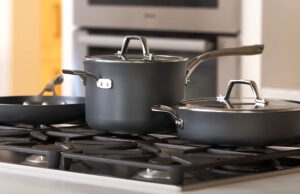As an Amazon Associate, I earn from qualifying purchases at no extra cost to you.
Microwave Caught on Fire with Nothing in it? Here’s What to Do
So, you just finished using your microwave, and the next thing you know, smoke is pouring out of it. Panic sets in—because there was absolutely nothing inside! You’re probably left wondering, “How in the world did this happen?” Trust me, you’re not alone in this. Microwaves catching fire with nothing in them may sound strange, but it happens more often than you think. In this post, we’ll explore why this can occur, how you can stay safe, and how to prevent it from happening again. Grab a snack (or a fire extinguisher) and let’s dive in!

Why Did My Microwave Catch Fire With Nothing Inside?
Microwaves are supposed to be convenient, quick, and easy kitchen appliances. But when things go wrong, they can cause serious issues—like fires. If your microwave caught fire with nothing inside, you might feel confused, frustrated, and maybe even a little scared. After all, a microwave is a simple machine that heats food, so why is it sparking and smoking when there’s nothing to cook?
Let’s break down the potential causes of a microwave fire with no food inside:
Electrical Problems
One of the most common reasons a microwave might catch fire without anything inside is an electrical malfunction. Microwaves rely on electricity to power their magnetron, which produces the microwaves that heat your food. If there’s an electrical problem—like a power surge, faulty wiring, or a malfunctioning component—it could cause the microwave to overheat or even spark, leading to a fire. This can happen even if there’s nothing in the microwave, as the appliance can still generate heat and cause a fire with just electrical issues.
Damage to the Microwave’s Interior
If your microwave is older or has been used for a long time, parts inside it may be worn out or damaged. For instance, the magnetron itself, which is responsible for generating the microwaves, could become faulty. When this happens, the microwave can start sparking or even catching fire. A worn-out or broken microwave should be checked by a professional to avoid further damage or dangerous incidents.
Metal Objects Inside the Microwave
Microwaves are designed to heat food, but when metal objects are placed inside, it can cause sparks. You might think there’s nothing inside, but there could be small metallic components or even something like a fork, a twist tie, or a piece of aluminum foil that got stuck somewhere unnoticed. Even the smallest piece of metal can cause a dangerous fire when exposed to microwave radiation.
Microwave Overheating
Another reason your microwave might catch fire with nothing inside is overheating. Microwaves are designed to cool down after use, but if there’s a problem with the cooling fan or vents, it can cause the microwave to overheat. This excessive heat could eventually ignite the internal components of the microwave, causing it to catch fire. It’s essential to ensure that the microwave is well-maintained and the vents aren’t clogged to avoid overheating.
Faulty Components or Circuitry
Sometimes, internal components like fuses, capacitors, or wiring can become faulty over time. If any of these parts malfunction, it can create a situation where your microwave catches fire even without food inside. These parts are crucial for the microwave’s operation, and any failure can cause dangerous situations. A malfunctioning microwave should be repaired or replaced to prevent these kinds of issues.
Common Causes of a Microwave Fire
It’s important to understand that a fire in your microwave doesn’t always mean that you’ve done something wrong. Microwaves, like any appliance, can experience problems over time. Here are some common causes that might explain why your microwave caught on fire, even when it wasn’t in use:
Overheating and Ventilation Problems
One of the most common causes of microwave fires is overheating due to poor ventilation. Microwaves have built-in fans to cool down after use. If these fans become clogged or damaged, the microwave can overheat, which can cause a fire. Ensuring the microwave is placed in a well-ventilated area and that vents aren’t blocked is essential to prevent this problem. Keep the area around your microwave clear, and be sure the vents aren’t obstructed by dust, grease, or debris.
The Use of Metal or Improper Materials
Never, under any circumstance, put metal objects inside the microwave. You might not realize that a tiny piece of foil or a metal fork could lead to disaster. Microwaves work by using electromagnetic waves to heat food, and when metal is introduced, it can cause arcing and sparking, which leads to fires. Always double-check your microwave before using it to ensure there’s nothing metal inside, including twist ties or metal clasps.
Failure to Follow Manufacturer’s Instructions
Another common cause of microwave fires is simply not following the manufacturer’s instructions. Every microwave is different, and using it incorrectly—such as putting items that are too big or using the wrong containers—can cause problems. Some items, like plastic containers that aren’t microwave-safe, can overheat or melt, potentially starting a fire. Always read the manual and follow the guidelines to ensure safe microwave use.
Broken or Worn-Out Components
Microwaves are made up of many parts, including the magnetron, fuses, and cooling fan. Over time, these components can wear out or break down. When this happens, it can lead to overheating or even fires. If your microwave is older or has been used heavily, it’s essential to have it checked by a professional to make sure everything is working correctly. Regular maintenance can help prevent electrical and mechanical issues that may result in a fire.
Faulty Wiring or Power Surges
Sometimes, it’s not the microwave itself but the electricity that’s the problem. A power surge or faulty wiring can cause an electrical malfunction in the microwave, leading to overheating or sparks. If your microwave is plugged into an overloaded outlet or there’s an issue with the power supply, it could result in a dangerous situation. Ensure your microwave is plugged into a grounded outlet and avoid using extension cords to reduce the risk of electrical issues.
How to Handle a Microwave Fire Safely
If your microwave ever catches fire—whether it’s due to an electrical issue, overheating, or something else—staying calm and knowing how to handle the situation is crucial. Here’s what you should do if a microwave fire occurs:
Don’t Open the Door
One of the first things to keep in mind during a microwave fire is to avoid opening the door. If you open the door, you’ll be allowing oxygen into the microwave, which can make the fire worse. Instead, leave the microwave door closed and unplug it from the outlet if it’s safe to do so. This will cut off the power supply and prevent further damage.
Use a Fire Extinguisher
If the fire is small and contained, a fire extinguisher can help you put it out. However, make sure the fire is not growing too large before you attempt to use the extinguisher. Always use a class C fire extinguisher for electrical fires. If you’re not familiar with how to use one, it’s a good idea to learn or have one on hand just in case.
Call the Fire Department
If the fire is getting out of control or you’re unsure about how to handle it, don’t hesitate to call the fire department. It’s always better to be safe than sorry. They have the expertise and equipment to put out the fire quickly and prevent any further damage.
Don’t Try to Handle a Large Fire Alone
If the fire becomes large or starts to spread, evacuate the area immediately and call emergency services. Microwaves, especially older models, can quickly become hazardous. Never try to put out a large fire yourself unless you’re trained to do so.
Preventing Future Microwave Fires
Microwave fires can be scary, but the good news is that you can prevent them by taking the right precautions. Here are some easy tips for avoiding a microwave fire in the future:
Regular Maintenance and Cleaning
One of the best ways to prevent a fire is to keep your microwave clean and well-maintained. Regularly clean the inside of the microwave to remove food splatters, grease, and debris. Clogged vents can cause overheating, so be sure to keep them clear as well. It’s also a good idea to have your microwave checked by a professional if it starts showing signs of wear and tear.
Be Mindful of What You Put Inside
Always check that you’re not putting any metal objects inside the microwave. This includes utensils, aluminum foil, or even twist ties. Stick to microwave-safe containers and avoid using plastic that’s not labeled as microwave-friendly. Additionally, make sure the food or beverage you’re heating is in a microwave-safe dish.
Upgrade Your Microwave When Needed
Microwaves don’t last forever. If your microwave is older or frequently causing problems, it might be time to upgrade. Modern microwaves are designed with better safety features, including auto-shutoff functions and improved ventilation. Investing in a newer model can help reduce the chances of a fire in the long run.
Follow the Manufacturer’s Instructions
Always follow the manufacturer’s instructions for your specific microwave model. These guidelines are provided for a reason, and they can help you avoid accidents or misuse. Pay close attention to the wattage, recommended cooking times, and any other important details.
I hope this guide has helped you understand why microwaves can catch fire with nothing inside, how to safely handle the situation, and how to avoid it in the future. By taking the right precautions, you can keep your kitchen safe and enjoy your microwave for many years to come.
Frequently Asked Questions
Is it safe to leave a microwave on when there’s nothing inside?
Leaving a microwave on without anything inside can cause it to overheat, which could lead to a fire. It’s best to avoid running the microwave without food or liquids inside.
Can I prevent a microwave fire by cleaning it regularly?
Yes! Regular cleaning helps ensure the microwave runs smoothly and reduces the risk of overheating or fire caused by debris or grease buildup.
Do I need to worry about my microwave if it’s old?
Older microwaves are more likely to experience problems, including faulty wiring or worn-out parts, which can increase the risk of a fire. It’s a good idea to replace your microwave if it’s more than 10 years old.
Can a microwave fire damage my kitchen?
Yes, a microwave fire can damage your kitchen. If the fire is large or spreads, it can cause significant damage to countertops, cabinets, and appliances. Always make sure the fire is under control quickly.
Is it safe to use a microwave that has been repaired after a fire?
If your microwave was repaired after a fire, it’s important to have it inspected by a professional to ensure that all components are functioning correctly. Don’t use it unless you’re confident it’s safe.
Can microwaves explode?
While rare, microwaves can explode if they are improperly used, especially if they’re overheated or contain the wrong materials. Always use your microwave as directed to avoid accidents.
Do microwaves have built-in safety features?
Yes, many modern microwaves have built-in safety features such as automatic shutoff functions, heat sensors, and better ventilation systems to prevent fires and overheating.
Is it safe to use a microwave with a damaged door or seal?
No, using a microwave with a damaged door or seal can be dangerous. The microwave may not heat properly, and there could be a risk of radiation leakage. Get it repaired before using it again.



